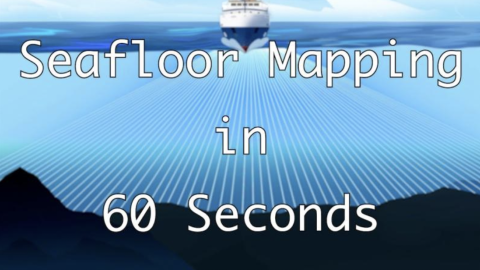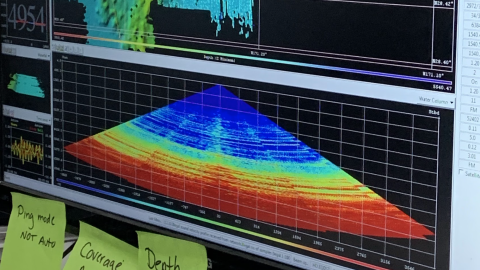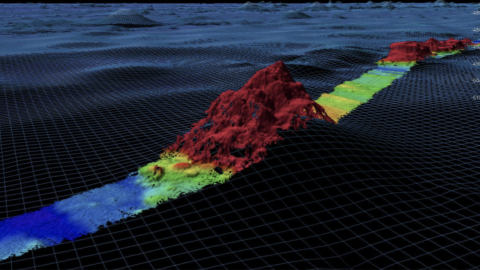Acoustic Systems
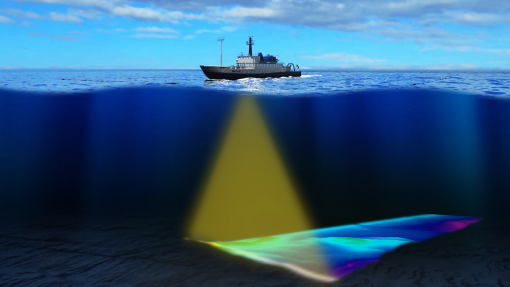
When exploring little-known regions of the ocean, we often need to create our own maps to plan efficient and safe operations. Nautilus is equipped with an acoustic echosounder that simultaneously collects bathymetric, seafloor backscatter, and water column backscatter data to enable the identification of areas or features of interest and the production of high-quality seafloor maps at depths to 7,000 meters (23,000 feet). Scientists onboard the ship may reference “mowing the lawn” and “pinging the seafloor,” which means our mapping systems are hard at work.
Whether focused on a canyon, seamount, or shipwreck, creating a map allows us to identify potential targets, cutting down exploration time and boosting our mission efficiency. Before ROVs are deployed, our team must first map the area to understand the characteristics of the region and identify potential benthic habitats, seeps, and other environments and resources worthy of exploration.
In addition to informing dive objectives, Nautilus transit routes cover unmapped areas of the ocean and contribute to the Seabed 2030 initiative, an international collaborative project to combine all bathymetric data in order to create a comprehensive map of the ocean floor. Since 2012, we have mapped over 1.2 million square kilometers (460,000 square miles) of the seafloor in the Atlantic, Gulf of Mexico, Caribbean Sea, and Pacific Ocean. Seafloor mapping began more than a century ago, yet less than 28 percent of the world’s ocean has been charted at high resolutions. In fact, we have better maps of Mars than of the seafloor!
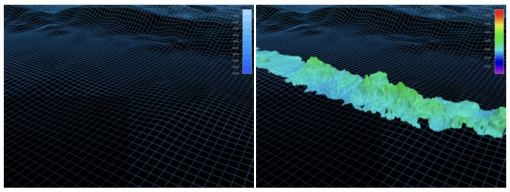
Mapping the World’s Seafloor with a Multibeam Echosounder
Mounted on the hull of the vessel is a Kongsberg EM302 multibeam echosounder capable of efficiently and accurately producing state-of-the-art maps covering large areas of seafloor. Our multibeam echosounder was installed in late 2012 and can map the seafloor at depths between 50 and 7,000 meters (160 to 23,000 feet) while cruising at ship speeds up to 12 knots (14 mph).
One transducer (the transmit array) emits acoustic pulses, that ensonify the seafloor with a wide fan-shaped swath of sound, while a second transducer listens for their return echoes. Each pulse sends many beams of sound in a fan shape toward the seafloor. When these pulses strike the seafloor and return to the transducer/receiver combination mounted on the hull of the ship, the system computes a “sounding” associated with each returning pulse via the time it took to travel down and up through the water column. The ship is moving between when the multibeam transmits and receives the signals, so a motion sensor connected to the system allows it to “steer” the sound pulses to correct for the ship’s rolling and swaying motions, and to collect an even distribution of data on the seafloor. Received soundings are combined with the ship’s Global Navigation Satellite System (GNSS) information, to produce a grid or “digital elevation model” of ocean bathymetry -- essentially a topographic map of the seafloor.
When you look at global maps of the ocean in programs like Google Earth it may look like we know all there is to know about the shape of the seafloor. It certainly looks like it, but this is because we are looking from far away, and these impressive-looking maps are built from sophisticated models that have very little modern depth observations and only the general highs and lows of deep-sea topography. There are two things about maps that change the detail of what we can see: scale and resolution. Scale is the size of the map and how big an area it covers, and resolution is the size of the smallest details you can see in the map. It is very similar to what we see out the window when we are flying across the country. When we are at 30,000 feet we can see very wide areas (small scale), but only see the outlines of towns, roads, and large features, and cannot see details (low resolution). However, as we are about to land the range of our view decreases (large scale), and we can see individual details of houses, cars on roads, and even people (high resolution).

The multibeam echosounder is the same in that as the depth changes, it acoustically “sees” different scales and resolutions at different depths. When Nautilus is mapping, the multibeam sonar fan covers a different width (scale) on the seafloor depending on the depth, however the number of measurements across the swath of the fan remains the same (resolution). So this means in shallow water the soundings are closer together and we can see many details of the seafloor in a small area. In deeper water, we see fewer details, but the multibeam fan of soundings covers a much wider area. As examples, in water depth of 100 meters the multibeam fan covers about 500 meters and the soundings are about 1 meter apart, whereas at a depth of 3,000 meters, the swath covers about 9 kilometers and the soundings will be about 10 meters apart.
In addition to the depth, the signal strength that the sonar receives back from the seafloor (“backscatter”) will be different depending on the type of seafloor that reflects the ping. By making corrections to this signal to account for the changes as it went through the seawater from the ship and back, the processing can extract information to indicate variations in the seafloor type. Reflections from rocky seafloor will generally provide a stronger signal than a muddy area. These backscatter measurements are combined in another grid called a backscatter mosaic, and this can be combined with the bathymetry grid to provide a better understanding of the shape and seafloor type.
Our multibeam echosounder can also detect phenomena in the water column, such as plumes of bubbles emanating from the seafloor that indicate gas seeps. From 2015 to present we have documented thousands of methane seeps along the Cascadia Margin off the Oregon and Washington coast.
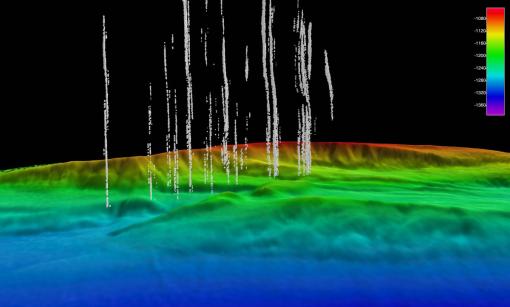
Exploring Sub-surface Geology with the Knudsen Sub-bottom Profiler and Echosounder
Revealing structures below the seabed is just as important as discovering the seascape and habitats above. Complementing our multibeam mapping work, our team utilizes a Knudsen 3260 sub-bottom profiler and echosounder. Mounted inside the hull of Nautilus, the echosounder operates at low frequencies to penetrate and reflect off of the layers of sediment, revealing a cross-section of the seafloor structure.
The dual-frequency profiler operates at 3.5Khz or 15Khz (two discrete channels with separate transducers) and is capable of full ocean depth soundings. An acoustic pulse is directed through the water column to the seafloor and then captured by the system as it bounces back from each layer. Scientists can use the data to identify subsurface geological structures such as faults, ancient channels, and buried levees.
New EC150 on E/V Nautilus Expands Ocean Exploration and Seafloor Mapping Potential
In early 2023, OET installed a new Kongsberg Simrad EC150-3C 150 kilohertz Transducer on E/V Nautilus. This new sonar is mounted within the ship's hull and the EC150-3C is the first of its kind to combine an acoustic Doppler current profiler (ADCP) and an EK80 split-beam fisheries sonar into one instrument. The ADCP, which measures the speed and direction of currents at various depths underneath the ship will support safe remotely-operated vehicle (ROV) operations and provide data for improving oceanographic current models. The integrated split-beam echosounder is used to map and characterize features found within the water column, such as biology, scattering layers, and potentially bubble plumes. The EC150 will equip E/V Nautilus with the capability to better serve as an operations hub for multi-vehicle operations, increase OET’s capacity to explore and map the water column, and to collaborate with partners from the Ocean Exploration Cooperative Institute to advance combined robotics and new technologies to increase and advance the pace of ocean exploration.
Underwater Navigation: Keeping Track of ROVs Argus and Hercules
It’s important that we know where ROVs Hercules and Argus are during each dive so they can find targets selected in the dive plan, and also to make sure we know the location of any discovery or sample taken on the seabed. We also want to keep them safe and away from any dangerous areas on the seafloor. Nautilus has a Global Navigation Satellite System (GNSS) to accurately position the ship and to continually measure the motion as the ship moves through the waves. However the GNSS doesn't work underwater, and an ultra-short baseline (USBL) navigation system helps us track Argus and Hercules when the duo is diving at extreme depths. There is a transceiver on the hull of Nautilus and each of the ROVs are outfitted with a transponder beacon to allow acoustic signals between the ship and each vehicle. The USBL sends an acoustic pulse through the water, or an electrical pulse down the cable to Hercules and Argus. When the ROV transponder receives the signal from the ship it responds with an acoustic pulse of its own. It’s as if the ship is asking the ROVs, “Where are you?” and receiving an “Over here!” response, similar to an underwater Marco Polo game. Once the USBL system receives the pulse, the position of each ROV relative to the ship is computed based on the travel time of the pulse and direction from which it is received, and it is then combined with the ship's position to calculate the location of the ROVs on the seafloor.
Science & Tech
Ocean exploration is a dynamic balance of understanding science and using the best in underwater technology.
Expeditions
Get a sneak peek of where we're headed next or revisit the discoveries of our past expeditions.
Classroom Resources
OET hosts a suite of free educational materials for use in classrooms, at home, or in the community.
Acoustic Systems At-a-Glance
Kongsberg EM302 Multibeam Echosounder
The EM 302 is a hull-mounted 30-kilohertz multibeam echosounder composed of two long transducer arrays mounted in a T-shape on the hull of E/V Nautilus. The EM 302 can map the seafloor in water depths from 10 to 7,000 meters (33 to 22,965 feet) at ship speeds up to 12 knots.
- 30 kHz
- 10–7,000 meters (33–22,966 feet)
- CW and FM chirp
- 1° × 1°
- 1–5 times water depth, up to 8 km (5 miles)
- 1-5% water depth (e.g., 10-15 meters [33-164 feet] at 1,000 meters [3,281 feet] depth)
Knudsen 3260 Sub-bottom Profiler and Echosounder
The Knudsen 3260 is a sub-bottom echosounder mounted inside the hull of E/V Nautilus. It operates at low frequencies (3.5 and 15 kilohertz) so that emitted sound can penetrate layers of sediment to about 80 meters below the seabed surface.
- Knudsen 3260 Chirp sub-bottom profiler and echosounder
- Dual frequency, 3.5 kHz and 15 kHz
- 4 kW on Channel 1 and up to 2 kW on Channel 2
- 50 meters to full ocean depth
Kongsberg Simrad EC150-3C Transducer
The Kongsberg Simrad EC150-3C 150 kilohertz is a hull-mounted transducer on E/V Nautilus that combines an acoustic Doppler current profiler (ADCP) and an EK80 split-beam fisheries sonar into one instrument. The ADCP measures the speed and direction of currents underneath the ship, whereas the split-beam echosounder maps features found within the water column.
- About 130 meters (426 feet)
- 3° at 150 kilohertz
- CW or FM
- 4
- customizable between 2-16 meters (6.5-52.5 feet)
Ultra-Short Baseline Navigation System
The ultra-short baseline (USBL) navigation system helps track the position of the ROVs in the water. The system consists of a hull-mounted transceiver on E/V Nautilus. Each ROV is outfitted with a transponder beacon to allow acoustic signals between the ship and each vehicle to determine their positions.
- Sonardyne Ranger 2 with Lodestar GyroUSBL transceiver deployed from the moonpool for USBL tracking of ROVs Hercules and Argus
- Up to 7,000 meters (22,966 feet)
- 0.5% of slant range
- +/- 90°
- 19 to 34 kHz
- Hercules, Argus, and two additional transponders are available. More targets such as can be tracked with the addition of compatible Sonardyne transponders.
